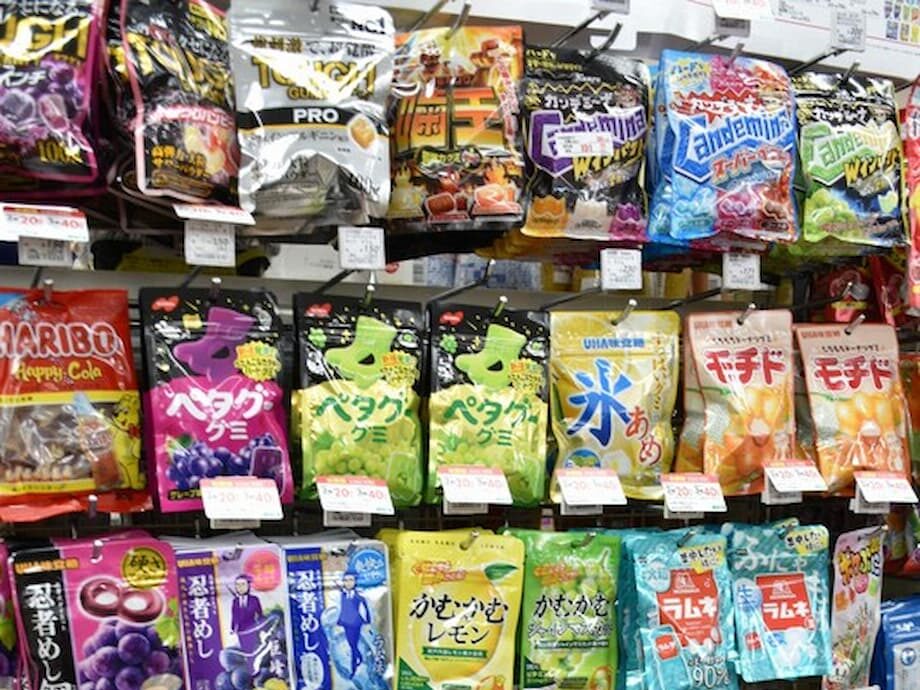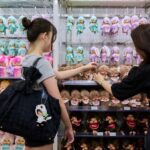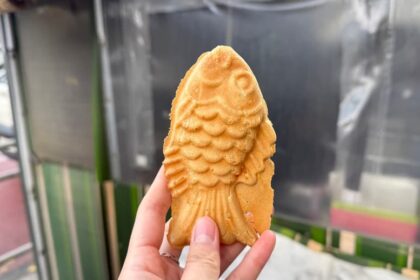A milestone in Japan’s sweets market
Gummy candy has claimed the top spot in Japan’s confectionery aisles for the first half of 2025. Sales reached 66.5 billion yen, edging past hard candy at 66.1 billion yen, according to market tracker Intage Inc. The shift, which coincided with Gummy Day on September 3, signals a real change in everyday snacking habits. Intage data also shows gummies have stayed ahead since April, making a full year lead more likely if current trends continue.
This momentum has been building for years. Gummies already overtook chewing gum in 2021 as gum sales slumped and chewy products drew new fans. In 2024, Japan’s gummy market rose 17 percent from the prior year to 113.8 billion yen, the first time it cleared the 100 billion yen mark. That total is roughly double the amount recorded in 2017. The drivers are practical and sensory at once: a broad range of flavors and textures, a clean and discreet format that does not require disposal like gum, and small pouches that fit on commutes, at desks, and on day trips.
Convenience stores and drugstores anchor this rise. Shoppers, including working adults and students, grab gummies as a quick refreshment, a palate cleanser after coffee, or a small bite to bridge a long day. Children love playful shapes and fruit-forward tastes. Visitors from overseas add more demand, treating gummies as portable souvenirs that travel well and feel distinctly Japanese.
How we got here: From gum slump to gummy boom
Japan’s gummy wave has been powered by a firm and chewy style that rewards a slow bite. Industry sources refer to this as the hard type gummy, a texture that gives a satisfying resistance before yielding. Sales of this segment have tripled since 2017, according to analysts, and the category’s ascent became unmistakable in 2021 when it surpassed gum. That same year, gum fell to about 59.3 billion yen, a sign of changing routines and fewer everyday chewing occasions.
Texture science is part of the story. At Meiji’s Hachioji Innovation Center, researchers built a chewing simulator and mapped bite resistance to better target different consumer needs, from focus to relaxation. The company has shared a chewiness chart to help match products to moods and moments. This data driven approach has helped fine tune mouthfeel, a key differentiator in Japan where texture plays a large role in candy enjoyment.
The outcome is a shelf full of contrasts: firm and snappy pieces, jelly-like centers inside sugar-sanded hearts, and sour styles that create a quick pucker then finish sweet. That diversity prevents fatigue and invites trial, which strengthens repeat purchases.
Why 2025 favored gummies
Seasonal patterns gave gummies an extra tailwind this year. Hard candy, including throat lozenges, tends to see a winter spike. Warmer months are kinder to gummies, which benefit when people seek small, refreshing bites and when dry throat remedies are less top of mind. Public health dynamics also matter. With infections easing in 2025, demand for lozenges fell back to earth.
Introducing the analyst who tracks these shifts, Toshimitsu Kiji of Intage explained how weather and health trends tipped the scales in recent months.
“Hard candy, especially throat lozenges, sees increased demand in winter, so it is easy for gummies to take the lead when temperatures are high. In 2025, infections like the coronavirus have settled, so the momentum for throat lozenges has weakened, while gummies continue to perform well.”
Monthly scans from April onward show gummies leading hard candy, which strengthens the case for a full year victory. Packaging plays a role too. Resealable pouches and small portion packs align with portion control and help avoid wrapper clutter, which adds to the appeal for commuters and office workers. Those same design choices have been credited with lifting gummy popularity in other markets, and Japan’s retailers have embraced them quickly.
Inbound tourism and the convenience store effect
Tourism adds another lift. Japan welcomed 36,869,900 foreign visitors in 2024, a record count, according to the national tourism bureau. That surge shows up in convenience store baskets and souvenir selections. Gummies are light, affordable, and easy to share, which makes them a natural pick for travelers filling suitcases before heading home.
One viral example offers a taste of this cross-border buzz. A Shine Muscat Grape gummy chocolate from 7-Eleven Japan drew intense attention on social media in China, South Korea, and Taiwan, driving sales to a reported ten times previous levels in six months. The combination of an unusual texture and a signature fruit flavor matches what many visitors seek: something instantly Japanese, priced for impulse buying, and easy to carry.
Convenience stores are the ideal stage for this category. They offer constant newness, with limited time flavors, regional fruits, and seasonal designs that keep regulars and visitors checking shelves. End caps and pouches at eye level make trial effortless. The format suits commuters and tourists alike, and it encourages a second purchase on the same trip when a favorite flavor hits.
That retail reality shapes how brands enter the market. Executives at Want Want, a Taiwanese snack maker expanding across Asia, chose gummies as a lead product for Japan, citing the category’s scale and the country’s benchmark status. The team prioritized offline channels such as 7-Eleven, Lawson, and FamilyMart, and layered in specialty chains like Don Quijote and Daiso. Localization in flavors, pack design, and marketing has been central, along with youth-focused events in places like Shibuya. The lesson is clear: shelf presence in convenience stores, plus tailored products and steady promotions, is a durable strategy in Japan.
From Cola Up to Juicy Gummy, Japan’s homegrown innovation
Japan’s gummy story is also a story of local invention. Meiji introduced the country’s first gummy candy, Cola Up, in 1980. The company then refined its formulas and molds, blending gelatin with pectin using a starch mold process common in Germany. In 1988, Meiji launched Juicy Gummy, designed to pair a comfortable chew with a fruit-forward taste and aroma. The result resonated with both children and adults and helped set the texture standards still seen today.
Meiji reports that Juicy Gummy holds a 17.0 percent share of the domestic gummy market over the period from April 2023 to March 2024, based on Intage SRI+ data. Fruit shapes that mirror actual produce and the use of fruit juice concentrates aim to deliver familiarity and authenticity. The company also calls out the absence of artificial coloring as a selling point.
Ingredient choices underline the texture. Gelatin, derived from collagen, gives elasticity and a springy bite. Pectin, a plant based gelling agent from fruit, adds structure and a slightly different snap. Makers can dial chewiness and softness by adjusting ratios, cooking temperatures, and acids, enabling a wide palette of textures from soft jelly centers to firm and resilient pieces.
That expertise makes room for innovation that feels distinctly Japanese. Regional flavors like muscat grape, yuzu, and white peach appear alongside citrus and cola, while sanding sugar or a sour powder coating adds a sensory kick. Precise molds, sometimes with detailed pulp textures, give each piece a premium look even at an everyday price.
Functional and plant based gummies are rising
Gummies are now a format, not just a candy. Around the world, people reach for gummy vitamins, probiotics, collagen, and sleep aids. This has reshaped the perception of gummies as easy to take and pleasant, with taste and texture lowering the barrier to daily use. The shift benefits confectionery because it normalizes gummies as a default choice for small treats and functional products alike. Japan’s supplement rules limit certain ingredients such as CBD, yet the global move toward gummy formats helps keep attention on the entire category.
Analysts at Future Market Insights estimate the global gummy market will reach about 30.4 billion dollars in 2025 and expand to roughly 92.7 billion by 2035, a compound annual growth rate near 11.8 percent. Clean label formulas, plant based or gelatin free recipes, and sugar reduced options are gaining ground. There are technical challenges in keeping gummies stable and tasty while lowering sugar or swapping gelling agents, but advances in pectin and starch systems, along with flavor technology, are helping makers maintain quality.
Functional segments show why the format is sticky. The market for melatonin gummies is projected to grow from around 1.4 billion dollars in 2025 to about 3.7 billion by 2035, and biotin gummies are expected to rise from roughly 1.89 billion dollars in 2025 to about 3.29 billion by 2035, according to market research firms. Those numbers sit outside pure confectionery, yet they condition shoppers to seek gummies for wellness as well as pleasure.
In Japan, drugstores and supermarkets stock both candy and supplements, and shoppers are accustomed to browsing the same aisles for each. Labels and claims are tightly regulated, so confectionery makers largely avoid specific health promises. Still, many explore vitamin enriched lines, collagen additions, pectin based recipes for vegan consumers, and sugar reduced formulations to serve health minded buyers without alienating traditional candy fans.
What brands are doing to win
Winning strategies start with texture and evolve through flavor. Hard chew gummies, soft centers, and sour sanding give makers multiple ways to stand out. Taste tests and travel pieces frequently highlight Japan’s sour segment and inventive textures. Products such as Bourbon’s Fettuccine Gummi, Kanro’s Pure Gummy lineup, and Nobel’s Chibi Sours show how brands combine mouthfeel and flavor to keep excitement high. Some reviewers even recommend freezing gummies for a crunchy-chewy bite, a simple trick that broadens how and when people eat them.
Packaging is a strategic lever. Resealable pouches and modest portion sizes introduce self control without losing indulgence. Transparent windows build trust. Limited time editions, regional fruit series, and collaborations turn a basic purchase into a collectible habit. The playbook rewards frequent innovation and precise refresh cycles.
Channel strategy matters. Convenience stores drive trial and impulse purchases, supermarkets support family sized packs, discount chains draw value seekers, and ecommerce extends reach for bulk and imported flavors. Brands pair in-store promotions with influencer campaigns, livestreams, and pop-ups to keep the category visible and fun. Market entrants say a long view is required to earn shelf space and consumer trust against entrenched local names.
Tourists are part of the audience plan. Flavors such as muscat, peach, yuzu, ramune, and cola appeal broadly across East and Southeast Asia, and they show up prominently in city center and airport shops. Price points below premium chocolate make gummies an easy add-on for gift bags and office sharing.
What it means for 2025 and beyond
If present trends hold, gummies are on track to finish 2025 ahead of hard candy on an annual basis in Japan. The lead has been in place since April, and the first half totals favor gummies, strengthening the case that the category’s new position will persist.
There are still timing effects to watch. Winter often lifts throat lozenges, which could narrow the gap late in the year. A warm autumn, strong inbound travel, and ongoing innovation in flavors and textures would favor gummies. Retail displays and limited time launches can amplify those advantages.
Sustained growth will likely reflect how well makers adapt to changing preferences and costs. Concerns about sugar intake will encourage sugar reduced recipes and smaller portions. Gelatin costs and supply may push more brands toward pectin and other plant based gels. For supplement gummies, regulators will continue to scrutinize dosages and claims. Companies that keep texture exciting, flavors fresh, and labels simple have the best chance to build loyalty across age groups.
For global confectioners, Japan remains a proving ground. Success with local fruit profiles, texture tuning, and convenience store distribution often transfers to broader Asia strategies. The current gummy lead is a data point that international teams will study closely.
What to Know
- Gummies sold 66.5 billion yen in Japan in the first half of 2025, ahead of hard candy at 66.1 billion yen, according to Intage.
- The gummy category doubled in size between 2017 and 2024 and rose 17 percent year over year to 113.8 billion yen in 2024.
- Gummies have led monthly sales since April 2025, raising the likelihood of a full year lead.
- Hard type gummies with a firm chew have driven growth and helped the category surpass chewing gum in 2021.
- Analyst Toshimitsu Kiji says warmer weather and easing infections reduced lozenge demand, giving gummies an edge.
- Japan recorded 36,869,900 foreign visitors in 2024, and tourist demand for gummies as souvenirs has increased.
- A Shine Muscat gummy chocolate at 7-Eleven went viral in parts of Asia, boosting sales roughly tenfold in six months.
- Meiji launched Japan’s first gummy in 1980 and reports a 17.0 percent share for Juicy Gummy in the year through March 2024.
- Global gummy demand is expanding into wellness, with plant based, sugar reduced, and functional products gaining ground.
- Brands compete through texture, limited time flavors, convenience store presence, and localized marketing.












